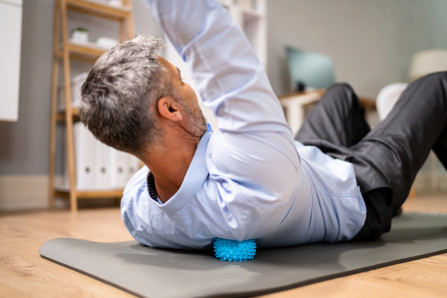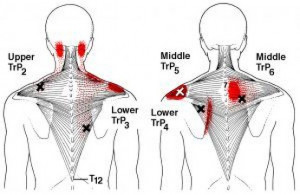Are massage guns effective- debunking the myth
Massage guns are heavily marketed as a substitute for professional therapists, providing benefits such as sports recovery and pain... Read Article

Trigger points or “pressure points” are a big cause of shoulder pain, and clinical trials show that treatment can give great relief.
However, if you follow most self help guides you won't get much benefits. This is because:
In this article we’ll share with a much more effective and complete system. It is based upon the successful clinical trials. Although it is much more thorough:
We include:
Trigger point and pressure points such as acupressure use largely the same points, but vary considerably in how you choose which points to treat and the way they are treated.
In this section:
Ancient civilisations found that certain points were associated with various conditions including shoulder pain, and that pressing on them or needling gave relief. Without modern science they had no idea what was going on so they made made up their own “science” with things like “meridians” and “energy flows” (1–6).
These points are just a collection of observations made of people with similar conditions over the years, so in summary, someone with a sore shoulder hundreds of years ago was relieved by treating certain points, so they press on the same spots with you.
Traditional therapists who practice these systems have no way of telling whether any particular point is really involved or not. The points are said to do things like block energy flows along meridians, but this "theory" is of abslutely no use in working out which points are involved. No one has found these energy flows, let alone build a measuring device to find out where they are blocked.
These points are treated with needles and pressure, as they have been traditionally for centuries.
More recently scientists have “re-discovered” these points calling them (myofascial) trigger points, or trigger points for short, and subjected them them to modern scientific analysis. Simply, they have found that they are parts of muscles that have spasmed or cramped, forming a lump and having a host of adverse effects on your body including referring pain. For more information please see our article Your Complete Guide To (Myofascial) Trigger Points .

A key difference between trigger points and “traditional points” is that there are concrete scientific ways to find trigger points and determine if they are involved or not. Importantly this also means the points can be re-checked to make sure treatment was successful.
While needles and pressure have been successfully used for centuries, scientific analysis of the points has enabled scientists to develop more efficient ways of treating them, such as the vibration massage discussed later.
As mentioned above most trigger point or pressure point guides for shoulder pain only show a hand full of points. However, the scientists found trigger points in 17 different muscles, and most gave multiple trigger points. While showing you a hand full of points makes for an attractive headline and an easy to follow guide, clearly they only address a small part of the problem so relief will be at best partial and temporary. Later in this guide we will show you an efficient way to systematically and quickly check them all.

The scientists who’ve investigated and successfully treated shoulder shoulder pain found problem trigger points in 17 different muscles(7,8). This chart from the trial report shows how common trigger points were in each of the muscles.
For example, over 50 of the 72 patients had trigger point(s) in their infraspinatus muscles (bottom line), while about 1/3 of the sufferers had trigger points in the least common muscles (scalenes and triceps). Having high percentages of trigger points in so many muscles of course means that most people had trigger points in multiple muscles.
This video discusses and demonstrates how we find the trigger points and the basic examination techniques. Later in this guide we will show you an efficient way to systematically and quickly check all 17 muscles.
In this section we will show you how to do the basic trigger point therapy, then later in this guide show you:
As mentioned above people have been pressing on points and sticking them with needles for centuries, and these therapies have strong advocates. While they are moderately effective, by studying the trigger points scientists have worked out more efficient and effective therapies. As discussed in The best treatment for trigger points , the best method is vibration massage. It is safe, highly effective, and easy to do on yourself.
In this section:

The scientists found that trigger points were a combination of muscle spasm, muscle tightness, reduced circulation and a build up of waste products. As this diagram shows therapeutic vibrations penetrate deeply into your muscles and help with all of these. For more information on the effects of therapeutic vibrations please see our guide The scientifically proven effects of vibration massage- with clinical applications .
Please check out our excellent videos below:
While there are a lot of vibrating massagers on the market very few are able to deliver the serious amounts of therapeutic standard vibrations need to effectively treat trigger points. This is why when looking for something for our Chiropractic patients to use we built our own . For more information please see our article How to choose a massager . However, you will need to avoid the following.

The market is flooded with massagers built by factories that have absolutely no interest in building serious therapeutic devices. As an example, our factory send me this machine to look at. Like most similar machines it came with cheap plastic gimmick shaped heads that are next to useless so I glued on a decent head from one of our massagers. When you use it though it feels like it’s not doing much and you need to press in to help it. That’s because it has got a low powered motor and it’s head doesn’t go up and down anywhere the amount a proper therapeutic device does.
Rather than having a pad that sits on the surface and sending in vibrations massage guns are designed to drive their heads in like jackhammers. Because of this they:
In this section we will go over each of the 17 muscles involved, including the common points for each. In the video we demonstrate the examination and treatment techniques for each, plus a systematic routine to quickly check and treat them all.
We’ll group three of the most important muscles together: infraspinatus, teres minor and teres major. As these diagrams shows they’re at the back of your shoulder blade. In these diagrams the “x”s are the trigger points and the red is where they usually shoot pain. The best way to massage these is lay on your side to put your arm up so the muscles are easy to access.



The upper trapezius muscle runs across the top of your shoulder and up the side of your neck. According to the scientists this was the second most common problem muscle for shoulder pain.
The supraspinatus sits underneath the upper trapezius muscle in a groove at the top of your shoulder blade. These are very easy to reach and examine for trigger points. The trapezius is at the top so you can easily start with the flats of your fingers, but supraspinatus is in a bit of a groove so you need to curl your fingers a bit to get to it.
Massage these sitting up, holding the massager with the opposite hand so the muscles I’m massaging are relaxed. If you sit up straight you’ll see the muscle is on slope so you need to grip the massager so it doesn’t slide off, but if you lean slightly across and forward it makes the part more horizontal so it’s a lot easier to hold. What you can do is move over the muscle systematically, giving anything you find a good soak. When you’re to the side over the top of supraspinatus just remember it’s deep and in a groove so give it a good soak.
The middle and lower trapezius ar best massaged sitting, leaning forward.


As these diagrams show they they run from your shoulder to part way down your arm, with part at the front, side and back. These are easy to reach and examine. And the easiest way to massage these is laying on your side. You roll backwards a bit for the front part, on your side for the side part, then forward for the back part of the muscle. Again, work systematically and give anything you find a good soak.

Now your biceps and triceps muscles are very easy to massage. It sits at the front and back of your arm running from your shoulder to your elbow so it’s very easy to reach and examine. To massage the muscle I just have the massager in the palm of my hand and go over the muscle systematically.

As these diagrams show the biggest muscle pectoralis major sits on top running from the centre of your chest to the top of your arm, while pectoralis minor sits underneath the outer part running roughly vertical.


There’s a muscle sitting under your shoulder blade called subscapularis. It normally sits between your ribs and shoulder blade where you can’t get to it, but if you bring your arm up like this your shoulder blade sticks out and you can get to it a bit. With every other muscle I use the flat head on my massager to get the best vibration transfer, but because this one is so hard to get to I use the domed attachment.
What I do is sit the head in there getting the best access I can, and this is where you’ll be really glad you’re using a vibration massager. You’ll never be able to poke your fingers or thumb in far enough to effective massage this muscle, but the vibrations will soak in. That said it is difficult and there are a lot of sensitive structures near there so I definitely recommend getting a professional show you and make sure you are doing it correctly

The last muscles are the scalenes that run deep along side of your neck. The scientists found that these were the least important of the 17 muscles, which is a good thing because I don’t want you self massaging them. They sit on top of sharp pointed parts of your spine right next to some major nerves and blood vessels. Leave these ones to the professionals.

While treating these muscles can be highly effective (7,9–14) there can be other issues causing shoulder pain. Please check out the following articles for more information.
Why shoulder pain keeps coming back and what you can do about it
Do exercises help shoulder pain

Most of our massagers sell through colleagues using our machines and recommending the therapy to patients/clients, so we are very happy to send appropriately qualified professionals a complimentary sample machine to trial. For more info please see our Professional sample sample page .
We are continually adding more information on research and uses. Subscribe below to have us email them to you "hot off the press".

Several years ago Dr Graeme, a Chiropractor practicing in Victoria, Australia was looking for a serious hand held massager his patients could use at home to get the extra quality massage they needed. The ones he found in the shops and on-line for home use looked nice but were not serious, and... read more
Massage guns are heavily marketed as a substitute for professional therapists, providing benefits such as sports recovery and pain... Read Article
In recent times it has become popular to use foam rollers as a substitute for conventional massage to help recover after sports and... Read Article
Massage is said to help healing and recovery. It certainly does, and in this article I’ll show you scientific evidence of some pretty... Read Article
Fibromyalgia is a sensitisation of the nervous system which causes pain to be amplified plus a host of other symptoms. While there are... Read Article
Vibration massage is an excellent therapy. However, too many massage guns fail to deliver this because: they use percussion which is less... Read Article
Using a hand held massager is simple. You place the vibrating head on the muscle, making good contact, and allow the vibrations to... Read Article
There are many possible causes of muscle fatigue, but by far the most common cause of muscle fatigue, but the most common and probably... Read Article
To become fitter, stronger and faster your need to push your body to create the microscopic damage that stimulates improvement. That... Read Article
Most professional athletes and sports clubs make heavy use of massage type treatments. The ability to do self massage using a hand held... Read Article
Do not refresh or leave this page until loading complete.